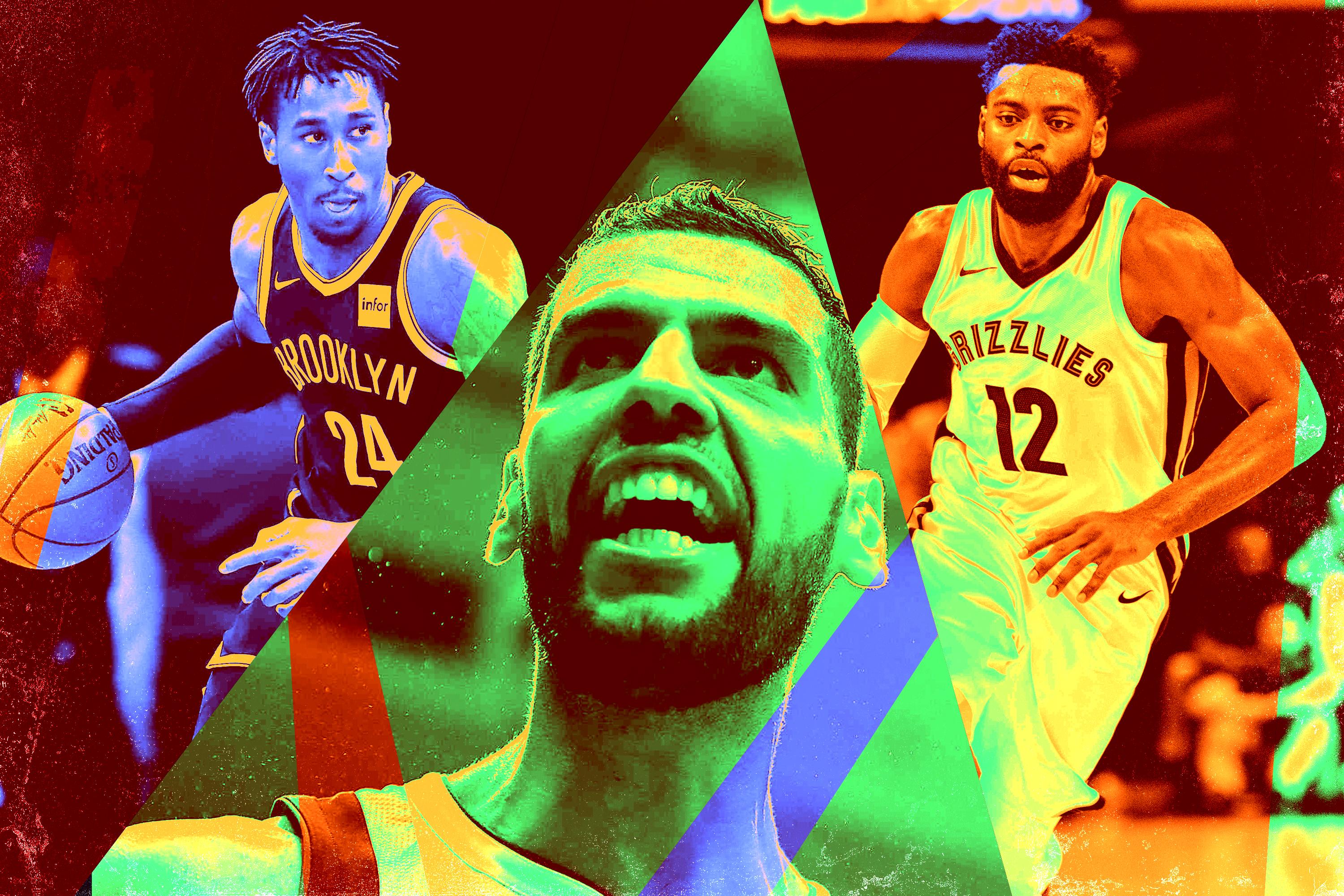
Everyone loves a star player (except, maybe, when the star is Russell Westbrook). But what about the guys doing the little things? Our staff picks out our favorite sneaky-good players doing work under the radar.
Sindarius Thornwell
Michael Baumann: I don’t know if Sin’s going to ever get past “sneaky-good” and go to unmodified good because there are good reasons he fell to the middle of the second round: He went into the draft as a 22-year-old, his size (6-foot-5 with a 6-foot-10 wingspan) is adequate but not ideal for a wing, and he isn’t a savant-like passer or a stone-cold knockdown 3-point shooter. Thornwell’s dominance and versatility in the college game had as much to do with his being a full-grown man in a sport dominated by teenagers as his skill.
But there’s also a reason Thornwell is getting 17 minutes a game as a rookie second-rounder: He plays like basketball is a matter of life and death. A huge part of defense and rebounding in the NBA is effort, and Thornwell will stay between his man and the basket if he has to litter the court with caltrops to do it. That’s not enough to make you an All-Star, but Thornwell is going to get rotation minutes for most of the next decade because coaches like players who know what they’re doing and hustle.
Rondae Hollis-Jefferson
John Gonzalez: Hollis-Jefferson doesn’t lead the Nets in any of the major counting categories. Not in points (that’s D’Angelo Russell), rebounds (DeMarre Carroll), assists (Spencer Dinwiddie), steals (Carroll and Caris LeVert), or blocks per game (Jarrett Allen). He doesn’t lead them in PER, true shooting percentage, box plus-minus, or win shares, either. But he’s been pretty good across the board, which is a marked improvement for RHJ because, during his first two seasons in the league, he was not anything approaching pretty good.
This season, Hollis-Jefferson is averaging 14.6 points per game on 48.5 percent shooting from the field, both of which are way up from last season (8.7 PPG, 43.4 percent). He’s getting to the line 5.5 times per game and hitting 83 percent (also way up). And he’s still only 22 years old. Plus—and this is my biggest argument—The Ringer’s Danny Chau rides so hard for Hollis-Jefferson that when I initially said this doesn’t feel like a very sexy pick, he admonished me. I’m still recovering. And maybe Danny is right. After all, dude pulled a LeBron earlier this year on LeBron.
Salah Mejri
Jonathan Tjarks: Nerlens Noel isn't sitting on the bench just because Rick Carlisle hates young players. It's also because the Mavs already have a guy who can do all of the things Noel’s supposed to be doing. Salah Mejri is a 31-year-old center from Tunisia in his third season in the NBA, and he has become one of the best shot-blocking big men in the league. He blocks 12.1 percent of opponents’ shots when he's on the floor, which leads the NBA among players with at least 10 games played by a whopping 2.6 percentage points. Part of that is because Mejri will jump at anything, and there's no pump-fake he won't buy (he averages 5.5 fouls per 36 minutes of action), but that's part of his charm, too.
Mejri first made a splash nationally when he shouted at Gregg Popovich and Tim Duncan after his dunk narrowed the Mavs’ deficit to 21 ... in the second quarter! Imagine someone with all of Joel Embiid's confidence and swagger, but about one-tenth of his ability. Mejri starts the game talking trash and he never really stops. If he blocks your shot and the ball starts going the other way, he's going to stop and let you know about it. As you can imagine, this does not win him many fans on opposing teams. Trevor Ariza, one of the most mild-mannered players in the NBA, once tried to follow Mejri into the Mavs locker room to fight him.
Mejri doesn't back down from anyone, and he seemingly has no grasp on what his skill level is. He's a 7-foot-1 center who once decided to channel Rex Grossman in the final seconds of a close game:
Mejri is in the final year of his contract on a rebuilding team, and the Mavs are overloaded at center. He's likely going to be moved by the trade deadline, so he might be coming to a city near you. He will be a fan favorite in a manner of weeks, and he's going to cause at least one major fight in a playoff series before his career is over. I can't wait.
Alex Abrines
Justin Verrier: The Thunder, aside from Wednesday’s blitzing of the champs, are not as good as they should be. Russell Westbrook is shooting poorly across the board, and managed to cheapen his signature outing thus far this season by hunting for stats late in the game. Paul George comes and goes. And most games feel like an outright refusal from Carmelo Anthony to accept the Boshian third chair. OKC indeed showed signs of a turnaround, but there’s still work to be done. And it begins by playing my beloved Abrines more often.
The Mutton Chopped Warrior’s box score production is … lacking. He’s averaging under five points a game, with few other worthwhile contributions. Even his 3-point shooting, the reason he’s out there, has been suboptimal (33.3 percent). But his plus-9.8 net rating is the highest on the roster among players logging over 15 minutes a game. It’s no big surprise, then, when you swap Abrines and Jerami Grant, a center in a supremely athletic wing’s body, in for Melo and Andre Roberson, OKC’s base unit gets extremely better (plus-25 net rating).
There’s a lot of noise in that 32-minute sample, especially when you consider the team’s regular starters have fared relatively well (plus-5.6). But if you asked me which players, in a vacuum, work best around the Thunder’s Actual Big Three of Russ, PG, and Steven Adams, I’d probably say athletes that can shoot, run, and defend. Grant may not be able to do a lot of the former, and Abrines may not currently be able to do a lot of the latter, but they’re far better fits for what this team needs than a superstar in name only.
Tyreke Evans
Paolo Uggetti: Evans started all 72 games he played in his rookie season, during which he averaged 20.1 points and won Rookie of the Year. It was the kind of role and impact you would expect out of the fourth overall pick. But over the next seven seasons, Evans just about bricked his way to “bust” status.
This season, his first with Memphis, Evans has yet to start a single game but he’s played better than he had in every season since his breakthrough rookie campaign. Evans is averaging 17.9 points while shooting 50.2 percent from the field and 41.7 percent from 3, all while coming off the bench. Call it a reclamation project, call it a contract year, call it whatever you want. The truth is the expectations have finally been lowered enough for Evans to exceed them. Who knows, maybe this was the role he was made to play all along.
Richaun Holmes
Haley O’Shaughnessy: Any following Holmes picked up last season in Joel Embiid’s absence has evaporated into thin, Processed air, both because the 24-year-old center missed the Sixers’ first eight games because of a fractured wrist and because Amir Johnson has claimed the majority stake on the backup-center minutes. Embiid is a tough act to follow; Holmes isn’t even the second act.
Holmes will live under the radar until Philly gets desperate for a refreshing and energetic force. Speedy rim-running and double-take dunks off the pick-and-roll define his offense, though he’ll also stretch the floor and knock down the occasional 3-pointer. The Bowling Green State product won MAC Defensive Player of the Year in 2015 and averaged one block last season. But he’s undersized at 6-foot-10 and lacks the refinement that could come with real developmental minutes. More minutes mean more Holmes dunks, and eventually, the NBA will learn it can’t live without these:
Nemanja Bjelica
Danny Chau: As a star for Fenerbahce Ulker, Bjelica’s most vital skill was his ability to create shots off the dribble. He’s a natural playmaker, even if his 6-foot-10 body didn’t always look the part. He attacked closeouts and whirled his way into the lane with impunity—there were few matchups he couldn’t exploit at the Turkish league level. While his talent has always been NBA-caliber, the same athletic advantages he saw in Europe evaporated in the NBA. It’s taken a few years to acclimate, especially under the pressure of playing for Tom Thibodeau, but Bjelica has emerged this season as a truly excellent low-usage role player. Bjelica is shooting a league-best 51.2 percent from 3, and with him on the floor the Wolves are outscoring opponents by 3.1 points per 100 possessions, which ranks fourth on the team.
The shift in efficiency occurred as Bjelica finally came to terms with his place on the Wolves. For a team that desperately needed to space the floor for its Big Three, Bjelica creating off the dribble was no longer imperative. Taking the 3-ball whenever possible became Thibs’s new directive. Strangely enough, despite his accuracy thus far this season, Bjelica is taking fewer 3s relative to his total field goal attempts than in either of his previous two seasons. It’s been an ironic trade-off: Buying into his role as a floor-spacing 4 and shooting a lights-out percentage has opened the floor for him to live out his old life as a creator in Minnesota every once in a while.

